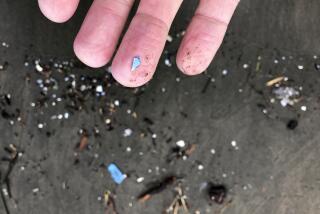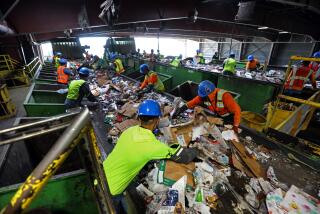Common chemicals linked to breast cancer
More than 200 chemicals -- many found in urban air and everyday consumer products -- cause breast cancer in animal tests, according to a compilation of scientific reports published today.
Writing in a publication of the American Cancer Society, researchers concluded that reducing exposure to the compounds could prevent many women from developing the disease.
The research team from five institutions analyzed a growing body of evidence linking environmental contaminants to breast cancer, the leading killer of U.S. women in their late 30s to early 50s.
Experts say that family history and genes are responsible for a small percentage of breast cancer cases but that environmental or lifestyle factors such as diet are probably involved in the vast majority.
“Overall, exposure to mammary gland carcinogens is widespread,” the researchers wrote in a special supplement to the journal Cancer. “These compounds are widely detected in human tissues and in environments, such as homes, where women spend time.”
The scientists said data were too incomplete to estimate how many breast cancer cases might be linked to chemical exposures.
But because the disease is so common and the chemicals so widespread, “the public health impacts of reducing exposures would be profound even if the true relative risks are modest,” they wrote. “If even a small percentage is due to preventable environmental factors, modifying these factors would spare thousands of women.”
The three reports and a commentary were compiled by researchers from the Silent Spring Institute, a women’s environmental health organization in Newton, Mass.; Harvard’s Medical School and School of Public Health in Boston; the Roswell Park Cancer Institute in Buffalo, N.Y.; and USC’s Keck School of Medicine. Silent Spring Institute Executive Director Julia Brody led the team.
In response to the findings, Susan G. Komen for the Cure, a breast cancer prevention group that funded the work, pledged an additional $5 million for developing research tools to root out environmental causes.
Reviewing hundreds of existing studies and databases, the team produced what it called “the most comprehensive compilation to date of chemicals identified as mammary carcinogens.” No new chemical testing was conducted for the reports.
The researchers named 216 chemicals that induce breast tumors in animals. Of those, people are highly exposed to 97, including industrial solvents, pesticides, dyes, gasoline and diesel exhaust compounds, cosmetics ingredients, hormones, pharmaceuticals, radiation, and a chemical in chlorinated drinking water.
“Almost all of the chemicals were mutagenic, and most caused tumors in multiple organs and species; these characteristics are generally thought to indicate likely carcinogenicity in humans, even at lower exposure levels,” they reported.
For many of the compounds, the federal government has not used animal breast cancer data when conducting human risk assessments, which are the first step toward regulating chemicals or in setting occupational standards to protect workers. Companies are not required to screen women who work with the chemicals for breast cancer.
“Regulators have not paid much attention to potential mammary carcinogens,” the researchers wrote.
Toxicologists say that other mammals, such as rats and mice, often develop the same tumors as humans do, and that animal tests are efficient means of testing the effects of chemicals. Environmental regulators, however, often want conclusive human data before taking action.
Animal studies generally use high doses of a substance to simulate a lifetime of exposure, and then the results are extrapolated to the lower levels that people are exposed to.
Ana Soto, a Tufts University professor of cell biology who specializes in cellular origins of cancer and effects of hormone-disrupting contaminants, said there probably was a link between breast cancer and exposures to chemicals in the environment, particularly early in life.
“I cannot say I’m convinced, but what I can say is that it’s a very likely, very plausible hypothesis,” said Soto, who did not participate in the new research. “More and more, cancer looks like an environmental disease.”
Twenty-nine of the chemicals are produced in volumes exceeding 1 million pounds annually in the United States.
Seventy-three are present in consumer products or are food contaminants -- 1,4-dioxane in shampoos, for example, or acrylamide in French fries. Thirty-five are common air pollutants, 25 are in workplaces where at least 5,000 women are employed, and 10 are food additives, according to the reports.
There are probably many more than 216, the research team said, because only about 1,000 of the 80,000 chemicals registered for use in the United States have been tested on animals to see whether they induce cancerous tumors or mutate DNA. Such tests cost $2 million each.
Because epidemiological studies are difficult to conduct and full of uncertainties, human data are “still relatively sparse,” the researchers wrote. Only 152 studies worldwide have examined whether women exposed to contaminants are more likely to have breast cancer -- compared with nearly 1,500 that have explored the links between diet and the disease -- and most of the 216 carcinogens were not included.
“Despite this large remaining gap, research in the last five years has strengthened the human evidence that environmental pollutants play a role in breast cancer risk,” the researchers wrote. They said the existing studies suggested “substantial public health impact.”
Human evidence is particularly strong for PCBs, or polychlorinated biphenyls -- compounds widely used in the 1940s to late 1970s that still contaminate fish and other foods -- and for polycyclic aromatic hydrocarbons, or PAHs, found in diesel and gasoline exhaust.
Solvents in dry cleaning, aircraft maintenance and other jobs also may increase breast cancer risk.
Some of the chemicals named as breast carcinogens already are regulated to protect public health, but some, particularly those in consumer products, are not.
The scientists conducted the review hoping to lay the groundwork for new human studies, as well as to persuade regulators to use existing animal data to strengthen regulations and require more testing of chemicals.
“Animal models are the primary means of understanding and anticipating effects of chemicals in humans,” they wrote. “All known human carcinogens ... are also carcinogenic in animals.”
Emerging evidence suggests that the roots of breast cancer are in infancy or the womb. More animal and human research should focus on such early exposure, said Patricia Hunt, a Washington State University School of Molecular Biosciences professor.
But Hunt and Soto urged society not to wait for scientific proof to reduce exposure to the chemicals.
“When you look at their list of chemicals, we are exposed to all of it,” Soto said. “We know humans are exposed to mixtures, and studying mixtures is very difficult. We will never have the whole picture, and it will take many, many years to collect epidemiological evidence, so we should take some preventive measures now.”
Although virtually all women are exposed to the chemicals, some may be more susceptible because of differing metabolism or ability to repair DNA.
Breast cancer is probably triggered by an interaction of multiple environmental and genetic factors.
Experts have long suspected diet plays a role. But the new research found “no association that is consistent, strong and statistically significant” for any particular foods raising or reducing breast cancer risk. There is substantial evidence, however, that regularly consuming alcohol, being obese and being sedentary increase risk.
About 178,000 new cases will be diagnosed this year in the United States.
The reports are at www.silentspring.org/sciencereview.
*
(BEGIN TEXT OF INFOBOX)
Chemical carcinogens
Researchers name 216 chemicals that cause breast cancer in animal tests. Here are some of the most widespread:
*--* Chemical Source/use 1,4-dioxane Detergents, shampoos, soaps 1,3-butadiene Common air pollutant; found in vehicle exhaust Acrylamide Fried foods Benzene Common air pollutant; found in vehicle exhaust Perfluorooctanoic acid Used in manufacture of Teflon Styrene Used in manufacture of plastics; found in carpets, adhesives, hobby supplies and other consumer products Vinyl chloride Used almost exclusively by the plastics industry to make vinyl 1,1-dichloroethane Industrial solvent; also found in some consumer products such as paint removers Toluene diisocyanate Used in foam cushions, furnishings, bedding Methylene chloride Used in furniture polish, fabric cleaners, wood sealants and many other consumer products PAHs Diesel and gasoline exhaust PCBs Electrical transformers; banned but still in environment Atrazine Widely used herbicide, particularly for corn
*--*
Source: Silent Spring Institute






